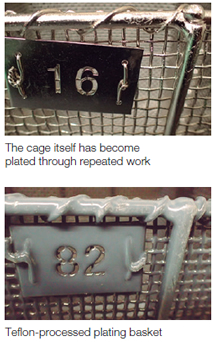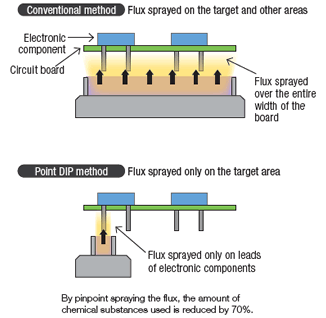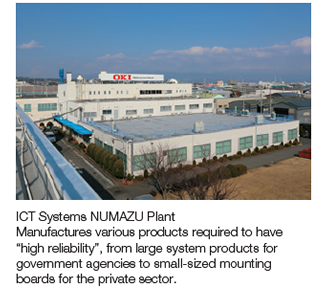- Home
- Sustainability
- Environment
- Approach by Businesses Toward Environmental Conservation
- Chemical management and reduction activities
Sustainability
Environment
Approach by Businesses Toward Environmental Conservation Chemical management and reduction activities
The OKI Group works actively to reduce harmful chemical emissions. This section presents some examples of our work on reducing chemical emissions by using approaches such as reviewing manufacturing methods and finding alternatives to chemicals used in processes.
Trial to Eradicate a Source of Pollution
Issue arising from continuation of plating work

In the plating process, the parts are attached to hangers, put in a basket, and soaked in the plating solution. As this process is repeated, plating becomes attached to equipment other than the parts, such as the hangers and the basket, which affects the work. It is therefore necessary to periodically remove the plating adhered to the equipment with nitric acid.
Nitric acid has been designated as a deleterious substance in the Poisonous and Deleterious Substances Control Act and it was used at the Mechatronics System Plant in the volume of 8,000 liters per year, which has been an issue.
Trial application of Teflon technology
"If we can stop the equipment from becoming plated, then we won’t need nitric acid" - The Mechatronics System Plant has been implementing Teflon processing of the cage. If the plating fluid is repelled and does not adhere to the basket, the basket will not become plated and harmful nitric acid will be unnecessary. Against the background of the technical evolution of Teflon processing, the Mechatronics System Plant trialled several methods and is verifying the cost-effectiveness of the results. This technology is expected to be rolled out to other manufacturing sites as an effective method of eradicating a source of pollution.
Reduction of Chemical Substances by Innovation of Manufacturing Method

In 2015, OKI Nextech introduced a point-dip (DIP) apparatus that scales-down the conventional method of immersing a substrate in a solder bath to pinpoint soldering for some of the processes to solder electronic components to circuit boards. In 2017, we increased the number of units and increased the rate of operation from 57% to 70%.
Flux is sprayed on the part to be soldered for pre-cleaning and prevention of oxidation. Isopropyl alcohol (IPA) is the main component of the flux. While IPA is relatively inexpensive and has high detergency, etc. it is highly toxic and is regulated by laws and regulations, so reduction of its use was an issue.
Since the point DIP apparatus conducts pinpoint soldering, it has the great benefit of reducing the usage of chemical substances contained in the flux such as IPA by 70%.
OKI Nextech jointly develops proprietary control software with equipment manufacturers so that soldering work on boards can be conducted in parallel while other circuit boards are being detached from the equipment to improve the operation rate of point DIP equipment. In addition to improving the operation rate, we also increased the number of units, and actively promoted cost reductions and reduction of environmental impact.
Reduction of Harmful Chemical Substance Emissions

At ICT Systems NUMAZU Plant, the manufacturing process for products to be used underwater involves work to fix parts with adhesive. Conventionally, the adhesive contained dichloromethane, which has a high environmental impact and strong toxicity, so measures were taken such as using local exhaust equipment to prevent workers from inhaling the steam. As the amount used at the plant already exceeded 200 kg per year and is expected to increase significantly as production increases, we have decided to switch to dichloromethane-free adhesives.
In replacing the adhesive, it was expected that the reliability test would be prolonged due to the strength required for underwater use and the long service life, but the design, manufacturing and quality divisions closely cooperated to review the items and objectives of the test, and were thereby able to significantly accelerate evaluation and application to the product.
Dichloromethane has been completely abolished at this plant and we are also promoting the reduction of hazardous chemical substances in other products.
Reports on misuse of public research funds and misconduct related to research
activities can also be filed from the page that opens when you click the above button.

